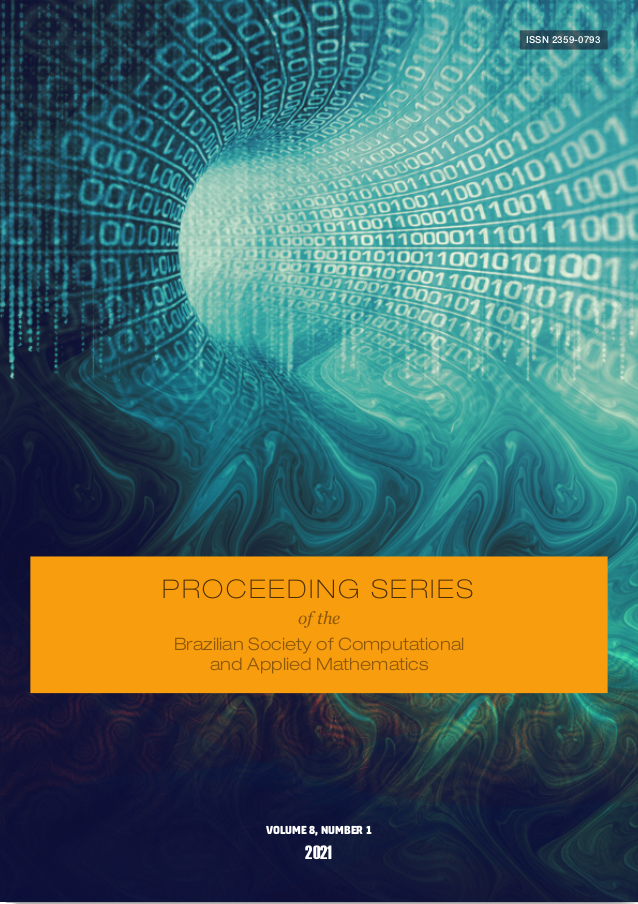Cálculo de Propriedades Termodinâmicas através da Equação de Estado Cúbica de Patel - Teja com os parâmetros estimados por Mota
DOI:
https://doi.org/10.5540/03.2021.008.01.0391Palavras-chave:
Patel-Teja, Mota, Volume de Líquido Saturado, Entalpia de Vaporização, TermodinâmicaResumo
Este trabalho apresenta um estudo analítico sobre a acurácia dos parâmetros estimados por Mota [10] para a equação de estado de Patel-Teja no cálculo das propriedades termodinâmicas, volume de líquido saturado e entalpia de vaporização. Com o objetivo de avaliar o poder preditivo dessas propriedades termodinâmicas para tal equação foram utilizados dados experimentais, bem como os parâmetros da proposta original de Patel-Teja.
Downloads
Referências
Abdollaht-Demneh, F. et al. Comparison of the prediction power of 23 generalized equationsof state: Part I. Saturated thermodynamic properties of 102 pure substances. Fluid phaseequilibria, Elsevier, v. 288, n. 1-2, pages 67-82, 2010.
Forero, L. A.; Vel ́asquez, J. A. A method to estimate the Patel- Teja equation of state cons-tants. Journal of Chemical & Engineering Data, ACS Publications, v. 55, n. 11, pages 5094-5100, 2010.
Forero, L.; Vel ́asquez, J. The Patel - Teja and the Peng - Robinson EoSs performance whenSoave alpha function is replaced by an exponential function. Fluid Phase Equilibria, Elsevier,v. 332, pages 55-76, 2012.
Haghtalab, A. et al. A new three-parameter cubic equation of state for calculation physicalproperties and vapor-liquid equilibria. Fluid Phase Equilibria, Elsevier, v. 293, n. 2, pages209-218, 2010.
Junior, A. M. S. et al. A new pot still distillation model approach with parameter estimationby multi-objective optimization. Computers & Chemical Engineering, Elsevier, pages 106-570,2019.
Kundu, P. K. et al. Genetic algorithm for multi-parameter estimation in sorption and phaseequilibria problems. Chemical Engineering Communications, Taylor & Francis, v. 205, n. 3,pages 338-349, 2018.
Mak, P. C.-N. Thermodynamic properties from cubic equations of state. Tese (Doutorado),University of British Columbia, 1988.
Menegazzo, T. A. et al. Application of an equation of state incorporating association toalcohols up to decanol. Fluid Phase Equilibria, Elsevier, v. 482, pages 24-37, 2019.
Mohsen-Nia, M.; Modarress, H.; Mansoori, G. A cubic hard-core equation of state. Fluidphase equilibria, Elsevier, v. 206, n. 1-2, pages 27-39, 2003.
Mota, B. T. Estima ̧c ̃ao de parˆametros de modelos termodinˆamicos via otimiza ̧c ̃ao multiobje-tivo. Tese (Doutorado), UERJ, 2019.
Patel, N. C.; Teja, A. S. A new cubic equation of state for fluids and fluid mixtures. ChemicalEngineering Science, Elsevier, v. 37, n. 3, pages 463-473, 1982.
Peng, D.-Y.; Robison, D. B. A new two-constant equation of state. Industrial & EngineeringChemistry Fundamentals, ACS Publications, v. 15, n. 1, pages 59-64, 1976.
Perry, R. H., Green, D. W., Maloney, J. O. (1997). Perry’s handbook of chemical engineering.Perry’s Handbook of Chemical Engineering.
Punnapala, S.; Vargas, F. M.; Elkamel, A. Parameter Estimation in Phase Equilibria Cal-culations Using Multi-Objective Evolutionary Algorithms. Multi-Objective Optimization inChemical Engineering: Developments and Applications, Wiley Online Library, pages 247-265,2013.
Smith, J. M., et al. Introdu ̧c ̃ao `a termodinˆamica da engenharia qu ́ımica. 7aedi ̧c ̃ao. LTC, Riode Janeiro, v. 200, 2007.[16] Soave, G. Equilibrium constants from a modified Redlich-Kwong equation of state. Chemicalengineering science, Elsevier, v. 27, n. 6, pages 1197-1203, 1972.

